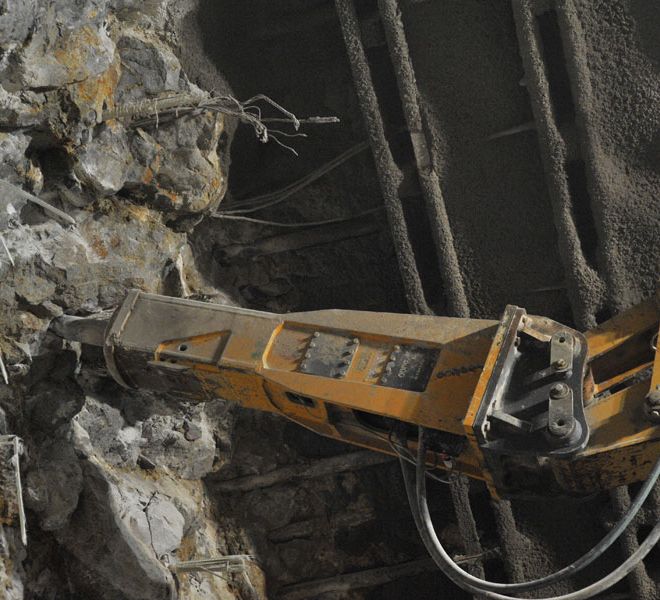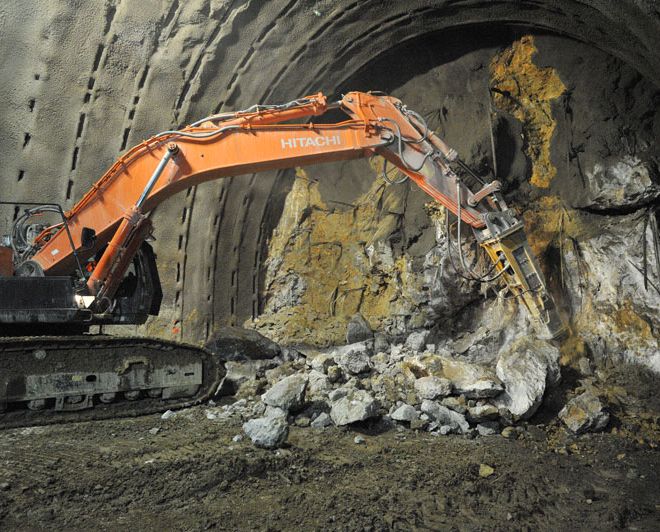SGC E 78 – Greppoli Tunnel
The HP 7000 hydraulic breaker and an HP 5000 were used for the excavation of a small tunnel where blasting could not have performed since the tunnel was being constructed alongside a trafficked road.
In March 2014, works were completed to excavate the “Greppoli” Tunnel situated between Grosseto and Siena in the section of road near Civitella Paganico on the SGC E 78, also referred to as the “Highway of the Two Seas” because it connects the Tyrrhenia coast with the Adriatic.
This major road is a category A highway, which when complete, in part by upgrading an existing route and in part by creating a new one, will connect Grosseto to Fano on a southwest/northeast axis. The 100-metre long Greppoli Tunnel is one of the many projects included in the macro-lot of Civitella Paganico (Grosseto) – Monticiano (Siena). Considering the geomechanical model, the short length of the tunnel, and the fact that in that particular segment the existing road to be upgraded ran nearly parallel to the new tunnel, the blasting method was discarded in favour of the hydraulic breaker. Selected to perform the works were Indeco HP 7000 breakers (in several short sections also using an HP 5000) utilized by Strabag, participating contractor in the Nuova F.A.R.M.A. Scarl Consortium assigned to perform the works of the new macrolot. Also included is another larger tunnel (Casal di Pari), it too excavated with Indeco breakers and in course of completion.
The geomechanical model
Data obtained from various geognostic surveys indicated that the rock mass through which the tunnel cuts was primarily characterized by cavernous limestone with medium-poor mechanical characteristics attributable to the RMR III-IV classes with short-term face stability but stable excavated section. However, during the stages of excavation there was determined to be a heterogeneous development of the rock from the south entrance where the tunnel face was opened. This featured limestone and compact microcrystalline dolomitic limestone, homogeneous, and resistant to being excavated. The compressive strength,evaluated via sclerometer tests (Schmidt Ltype breaker) in that section was variablebetween JCS=39÷44 Mpa. Advancing fromthe south entrance and working north,the rock mass immediately underwent aprogressive deterioration in quality andwidely demonstrated the presence ofmore altered portions of the formationcomposed of breached limestone includingdolomitic clasts with variable granulometrygenerally coarse-grained with calcareouscementation, from altered to very altered,slightly fractured, and relatively resistantto excavation. The compressive strengthof this section, evaluated via sclerometertests (Schmidt L type breaker) was insteadvariable between JCS=28÷33 Mpa. The discontinuity and marked fracturing of therock mass prompted engineers to performshort-term reinforcement of the stable faceusing injected fibreglass tubes and subhorizontal reinforcement elements (Adeco RS system). The works to reinforce the face had an impact on project completion time, but was necessary in order to guarantee medium-term stability, which was put at risk due to the characteristics of the rock mass.
The excavation
As pointed out earlier, the tunnel measured 100 metres and according to the section, had an excavation face with a surface that varied from 136 to 143 sq. m (two carriageways plus emergency lane). Initially, due to the hardness and compactness of the rock characterized by limestone and compact microcrystalline dolomitic limestone, excavation output was low and chisel wear was higher than average. However, by using “Cobra” chisels and then, once reaching the more fractured material, output stabilized at an average excavation rate of approximately 14 cubic metres per hour corresponding to an average advance rate of two linear metres per day, considering the time required for the pre-shotcrete and first-phase lining (shotcrete, rib assembly and installation). Again, the invert was constructed using the breaker. Works commenced in early November 2013 and were completed in early March 2014.









